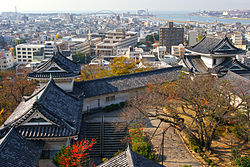Wakayama Castle
| Wakayama Castle 和歌山城 | |
|---|---|
| Wakayama, Wakayama Prefecture, Japan | |
 The reconstructed concrete tenshu (keep) | |
| Type | Hirayamashiro (hilltop castle) |
| Height | Three stories |
| Site information | |
| Condition | The tenshu and some connected buildings were reconstructed using concrete in 1958. |
| Site history | |
| Built | 1585-1586 |
| Built by | Toyotomi Hidenaga |
| In use | 1586 to 1868 |
| Materials | Earth, stone, and wood |
| Demolished | Most of the castle during the Meiji Restoration, though the tenshu survived until its destruction from firebombing in 1945. |


Wakayama Castle (和歌山城, Wakayama-jō) in Wakayama, Wakayama Prefecture, Japan, sits at the mouth of the Kii River. Originally Ōta castle, home of the Saiga Ikki, it was captured by Toyotomi Hideyoshi in 1585, during the Siege of Negoroji; many monks from Negoroji sought refuge in Ōta, which was soon destroyed by flood. Hideyoshi ordered the building of dams on three sides of the castle, focusing the rainwaters and diverting the river to ruin the castle. As hunger set in, the samurai, monks, and peasants inside Ōta surrendered, and fifty warrior monks led a final charge against Hideyoshi's army, committing honorable suicide.
Ōta was rebuilt as a temple for the Shinshu branch of Japanese Buddhism, severed from its history as a home to warrior monks. Wakayama Castle was then built on the same site, under the supervision of Toyotomi Hidenaga, Hideyoshi's brother, with Tōdō Takatora's participation. Asano Yoshinaga arrived in 1600 to serve as feudal lord, under Tokugawa Ieyasu. The castle was later attacked, in 1615, by forces loyal to Toyotomi Hideyori, who were trying to end the siege of Osaka.
In the summer of 1615, parts of the Osaka garrison left the city, ambushing various elements of the Tokugawa forces. Ono Harunaga, Hanawa Naoyuki and Okabe Noritsuna led part of the garrison in attacking Wakayama Castle, held by Asano Nagaakira at the time. They had with them 3000 men, but the castle boasted 5000 in its garrison. Asano's men left the castle to meet the Western (Toyotomi) forces in what came to be known as the 'battle of Kashii.' Hanawa and Okabe were killed, and Ono was forced to flee back to Osaka.
The castle's current appearance is the result of renovations made by Tokugawa Yorinobu, tenth son of Tokugawa Ieyasu, in the early 17th century.
At the end of the Edo period, in 1867, the feudal structure fell apart, and Wakayama Castle was opened to the public for the first time.
The castle was destroyed by Allied bombing during World War II, but was rebuilt in 1958 out of concrete and is open to the public as a symbol of the city and historical site.
Literature
- Schmorleitz, Morton S. (1974). Castles in Japan. Tokyo: Charles E. Tuttle Co. ISBN 0-8084-1102-4.
{{cite book}}: Check|isbn=value: checksum (help) - Motoo, Hinago (1986). Japanese Castles. Tokyo: Kodansha. p. 200 pages. ISBN 0-87011-766-1.
External links
![]() Media related to Wakayama Castle at Wikimedia Commons
Media related to Wakayama Castle at Wikimedia Commons
